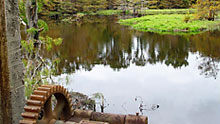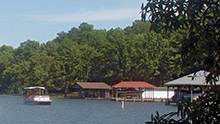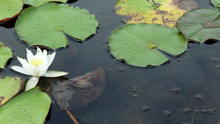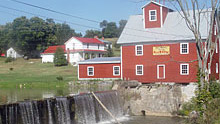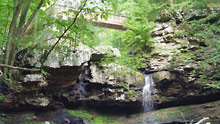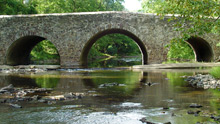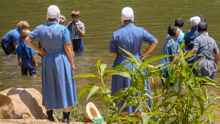Rhapinema dacryon Thompson 1969
> Habitat & Distribution
Notogillia sathon populations range across central Georgia from tributaries of the Oconee and Ocmulgee River systems in the east to the Chattahoochee and Flint drainages in the west, south into the panhandle of Florida. Watson (2000) characterized the habitat as "relatively undisturbed pools of springs or small streams," with substrate "mud-silt-sand mixture, sometimes with leaf litter and woody debris." Notogillia sathon demonstrated non-apparent rarity in our 15-state study region, FWGNA rank I-3*, although our ranking system has not been updated to include Gulf drainages of Georgia.
> Ecology & Life History
Hydrobiids seem to be rather nonspecific grazers of small particles (Dillon 2000: 94-97). They are typically dioecious, the males being characterized by a penis that arises from the neck. Females attach single eggs in spare, hemispherical capsules to solid substrates (Hershler 1994). No specific life history data are as yet available for N. sathon.
> Taxonomy & Systematics
Notogillia sathon was one of the three hydrobiid species (along with Marstonia agarhecta and Spilochlamys turgida) described by Thompson (1969) as endemic to springs and spring-fed tributaries of the Ocmulgee River in the vicinity of Hawkinsville, Georgia. And like S. turgida, Thompson subsequently discovered several populations in the upper Oconee drainage to the east. Very similar hydrobiid populations inhabiting Chattahoochee/Flint drainages to the west, however, he identified as Rhapinema dacryon.
Thompson described Rhapinema dacryon in the same (1969) paper that he described N. sathon, distinguishing the two taxa by detail of penial morphology. Our research with populations of the western hydrobioid Pyrgulopsis (Liu & Dillon 2021), however, has returned no evidence of reproductive isolation correlated with variation in penial lobes, papillae, or glandular regions, nor any support for the hypothesis that such minor details of penial morphology might suggest specific significance. (See our essay of 7Sept22 from the link below for more.) Thus, we consider Rhapinema dacryon (Thompson 1969) a synonym of Notogillia sathon (Thompson 1969).
In overall morphology the penis of Notogillia is typically nymphophiline, spatulate or blade-shaped with surficial glandular patterns (Kabat and Hershler 1993). The genus was retained, along with such other nymphophiline genera as Marstonia, Floridobia, and Pyrgulopsis, in the new, pared-down Hydrobiidae (ss) by Wilke and colleagues (2013).
Hershler et al. (2003) included a single N. sathon CO1 sequence (AF520932, identified as R. dacryon) in a gene tree for the North American nymphophilines. Their analysis suggested close evolutionary relationships with Notogillia and Cincinnatia, as well as N. wetherbyi.
> Maps and Supplementary Resources
- Notogillia distribution in Atlantic drainages (2023)
- Notogillia distribution in Georgia and the Florida panhandle (2025)
> Essays
- Conservation-biased oversampling of Notogillia sathon was featured in my blog post of 19Mar12, "Toward the Scientific Ranking of Conservation Status - Part III."
- Earlier versions of this website, online until August of 2016, adopted the large, broadly-inclusive concept of the Hydrobiidae (sl) following Kabat & Hershler (1993). More recently the FWGNA project has shifted to the Wilke et al. (2013) classification system, distinguishing a much smaller Hydrobiidae (ss) and elevating many hydrobioid taxa previously ranked as subfamilies to the full family level. For more details, see The Classification of the Hydrobioids.
- See my essay of 7Sept22, Just 125 species of Pyrgulopsis in the American West, for a review of the paper by Liu and Dillon (2021) demonstrating striking variation in both shell and penial morphology within a single population of Pyrgulopsis gibba.
> References
Dillon, R. T., Jr. (2000) The Ecology of Freshwater Molluscs. Cambridge, Cambridge University Press. 509 pp.
Hershler, R. (1994) A review of the North American freshwater snail genus Pyrgulopsis (Hydrobiidae). Smithsonian Contributions to Zoology 554:1-115.
Hershler, R., H. Liu, and F.G. Thompson (2003) Phylogenetic relationships of North American nymphophiline gastropods based on mitochondrial DNA sequences. Zoologica Scripta 32:357-366.
Kabat, A.R., and R. Hershler (1993) The prosobranch snail family Hydrobiidae (Gastropoda: Rissooidea): review of classification and supraspecific taxa. Smithsonian Contributions to Zoology 547:1-94.
Liu, H-P, and R. T. Dillon, Jr. (2021) Resolving the species status of Surprise Valley Pyrg (Pyrgulopsis gibba) and Vineyard Pyrg (Pyrgulopsis vinyardi). Report to Stantec Environmental Consulting. FWGNA Circular 6: 1 5. [pdf]
Thompson, F.G. (1968) The Aquatic Snails of the Family Hydrobiidae of Peninsular Florida. University of Florida Press, Gainesville, Florida, USA.
Thompson, F.G. (1969) Some hydrobiid snails from Georgia and Florida. Quarterly Journal of the Florida Academy of Sciences 32:241-265.
Thompson, F.G. (1999) An identification manual for the freshwater snails of Florida. Walkerana 10: 1 96.
Watson, C. N. (2000) Results of a survey for selected species of Hydrobiidae (Gastropoda) in Georgia and Florida. pp. 233 - 244 in Freshwater Mollusk Symposium Proceedings (Tankersley et al, eds) Ohio Biological Survey, Columbus.
Thompson, F. G. & R. Hershler (2002) Two genera of North American freshwater snails: Marstonia Baker, 1926, resurrected to generic status, and Floridobia, new genus (Prosobranchia: Hydrobiidae: Nymphophilinae). The Veliger 45: 269 - 271.
Wilke T., Haase M., Hershler R., Liu H-P., Misof B., Ponder W. (2013) Pushing short DNA fragments to the limit: Phylogenetic relationships of hydrobioid gastropods (Caenogastropoda: Rissooidea). Molecular Phylogenetics and Evolution 66: 715 736.

